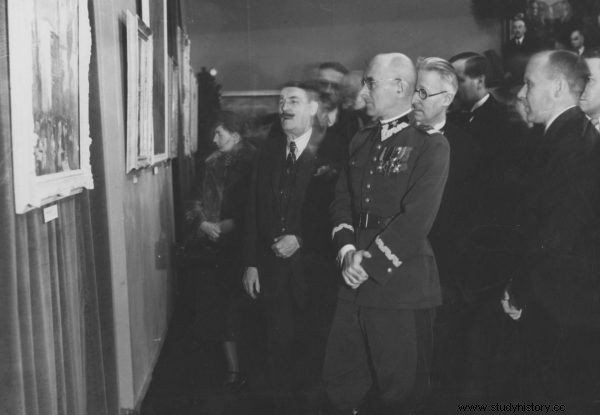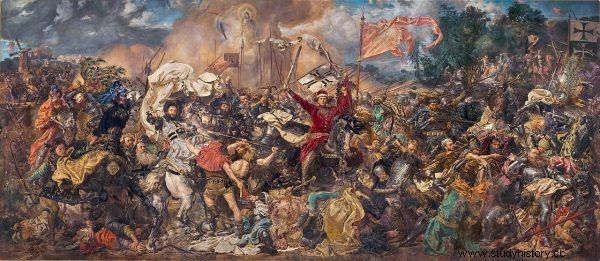The recommendations were issued a few months before the war broke out, but nobody made sure that they were implemented. Real work started on the eve of the expected invasion. And the stake was the entire legacy of Polish culture.
In the spring of 1939, in an atmosphere of war threat, Dr. Władysław Zawistowski, head of the Department of Art of the Ministry of Religious Denominations and Public Education, provided guidelines for securing the property of Polish culture in the event of an armed conflict. On-the-spot protection was to apply to:
Movable monuments:archives, libraries, museums, public and private collections, church treasuries and more valuable monuments belonging to public corporations and private persons. However, the evacuation will cover only works of exceptional value, mainly Polish art, manuscripts, old prints and archives concerning the history of Polish statehood.
Unfortunately, the ministry limited itself to issuing recommendations, counting on the independent initiative of directors and private owners of museums, libraries and archives.
She was brought in secret, falsely signing the boxes. The National Museum in Warsaw
Stanisław Lorentz, director of the National Museum in Warsaw, mentioned the steps he had taken to protect the collections in the institution he was managing:
After a second thought, I decided not to take anything away - there was nowhere to go - and if possible, secure the collections on the spot. I thought that the collections could not be dispersed and located somewhere in palaces or country mansions or, for example, in monasteries distant from large centers, because then they would be at risk of being burned or plundered during war accidents, and we would not be able to provide these collections with sufficient care by the museum staff.

The director of the National Museum in Warsaw, Stanisław Lorentz (on the right), decided not to take the collections of the institution he headed anywhere.
It turned out later that my reasoning was correct. In April, in the museum's carpentry shop, we started to prepare forged wooden boxes, inside them stamped with zinc sheets. Several hundred of them were made. At the same time, the curators began to prepare as confidential lists of crops that had to be packed in order.
In June, Roger Raczyński contacted me asking if I would agree to deposit the Rogalin paintings gallery at the Museum. It was brought in secret, misrepresenting the boxes. In July and August, further deposits began to flow in. On August 25, we started packing the collections according to the established lists and we carried the boxes to the museum vaults.
Many works from rural and city palaces were then taken into the care of director Lorentz and his team. It seemed that Warsaw and the towns located more to the east would be safe and could be saved against the invaders' actions.
Darkest under the lantern. Evacuation of Krakow's treasures
Preparations in the event of war were also made at the National Museum in Krakow, led by Professor Feliks Koper. In mid-August 1939, the collections were packed there and transported from the Cloth Hall to the air raid shelter located in the newly built Museum building at 3 Maja Avenue. The numismatics were placed in barrels and buried.
A wonderful Prussian Homage Jan Matejko was deported after the first air raids on the city on September 1, 1939 and hidden in Zamość, in the basement of the church of St. Catherine. However, the Gestapo found his trail. Since, according to the adage, it is darkest under the lantern, Poles transported the painting back to Krakow on November 17 and hid it in the Emeryk Hutten-Czapski, a branch of the National Museum, where he calmly lived to see the end of the war.
The famous altar by Wit Stoss from St. Mary's Church was dismantled in the second half of August 1939 under the supervision of doctor Karol Estreicher Jr. by Krakow firefighters. Its main elements were packed in wooden boxes and floated down the Vistula to Sandomierz. There, on the day of the outbreak of the war, they were hidden in the Gothic, 14th-century cathedral of the Nativity of the Blessed Virgin Mary and in the diocesan theological seminary.
28 chests have been walled up in the basement. Securing private collections
Private collections of works of art were mainly evacuated from the areas bordering the Third Reich. The collections of Raczyński from Rogalin have already been mentioned. The Czartoryski family moved the most valuable exhibits from their famous collection from Gołuchów near Poznań and Kraków to the outbuilding of the palace in Sieniawa. There were: Lady with an Ermine Leonardo da Vinci, Portrait of a Young Man by Raphael Santi and Landscape with the Good Samaritan Rembrandt, as well as masterpieces of goldsmithing art and historical mementoes of Polish kings.

Karol Estreicher junior was responsible for evacuating the treasures of Polish culture from Krakow.
In the basement of a tenement house belonging to the family at Kredytowa Street in Warsaw, 28 chests and tin pipes filled with precious antique objects from Gołuchów, ancient bronzes, ivory products, Limousine enamels, Greco-Roman glasses, paintings of 16th-century French and German masters or personal gifts.
The most valuable works from the Tarnowski family collection, exhibited at the castle in Dzików near Tarnobrzeg, were taken to the Princes Lubomirski Museum in Lviv. The collections of the archive and the library were walled up in the castle's cellars and in the tomb crypt under the Dominican monastery.
Count Alfred Potocki skilfully hid part of his collection in various hiding places in the palace in Łańcut, while the rest of the collection remained in its current places.
Arrasy on the barge. Evacuation of works of art after the outbreak of the war
After the outbreak of the war, Poles continued the evacuation of the most valuable monuments. The most dramatic course was the action of removing 250 objects, including 138 16th-century so-called Wawel tapestries purchased by King Zygmunt II August, from the collection of the Wawel Royal Castle. Due to the lack of adequate means of transport, they were evacuated by a Vistula coal barge in the late evening of September 3, 1939, under the care of the castle employees.

Wawel tapestries were evacuated by barges on September 3. Ultimately, they only found a safe haven in Canada.
After many adventures caused by the rapid advances of the German troops, the reign of the Luftwaffe in the air and difficulties in obtaining fuel, this unusual means of transport with an equally unusual cargo, after covering about 250 kilometers, reached the shore in the town of Mięćmierz near Kazimierz Dolny. From there, thanks to the involvement of many local people of good will and the help of the army, the treasures of Wawel were removed - on September 18, 1939, they crossed the Romanian border.
Then, via the port of Constanza, and then Constantinople, Piraeus, Malta, Palermo and Genoa by sea, they reached Marseilles in France. After its fall, Polish treasures found themselves in London, from where, due to the threat of invasion, they were finally shipped to Canada by the Polish ocean liner "Batory". They only returned to Poland in 1961.
Battle of Grunwald on a horse platform
Equally dramatic circumstances accompanied the evacuation of the famous Battle of Grunwald Jan Matejko. The work of art on display at the Zachęta Gallery in Warsaw, depicting the victory of Poles over the Teutonic Order, influenced the Nazis, who preached theories about the superiority of the Teutonic race over the Slavs, like a red rag for a bull.
The painting was packed in a crate and taken from the bombed capital on September 7, 1939 on a horse platform. Transport was assisted by the administrative director of Zachęta, Stanisław Mikulicz-Radecki with his wife, vice-president of Zachęta, artist painter Stanisław Ejsmond and artist painter Bolesław Surałło. During the two-day journey, the horses shot by German planes were changed twice.

The Germans especially wanted to get their hands on Jan Matejko's "The Battle of Grunwald".
Ultimately, the painting was hidden in a specially constructed library counter at the Lublin Castle, which is the seat of the local museum. In the streets of Lublin, during the intense bombing of the city, Ejsmond and Surałło died under the rubble.
Mościcki takes treasures from the Royal Castle
A number of valuable collections were also taken to the east from the Royal Castle in Warsaw, the seat of the President of the Republic of Poland, as part of the evacuation of the office. As Stanisław Lorentz writes, there were:"two paintings by Matejko" Batory near Pskov "and" Rejtan at the Warsaw Sejm "(...), 2 tapestries with the coat of arms of Chalecki and 17 packages with tableware". Among the items taken away, there was also an extremely valuable Persian silk rug, the so-called A 16th-century Wilanów carpet, which has a legend that it was captured by the troops of King Jan III Sobieski near Vienna.
The transport of all goods together with President Ignacy Mościcki soon found themselves at the Radziwiłł castle in Ołyce in Volhynia. Mościcki left there that valuable deposit, which was later seized by the Soviet army. As a result, Matejko's paintings were placed in the museum in Lutsk. Later they were taken over by the Germans, but no trace of the Persian carpet was left.
Bibliography:
The article is an excerpt from the book by Dariusz Kaliński entitled "Balance of harms. What the German occupation of Poland really looked like. ”
